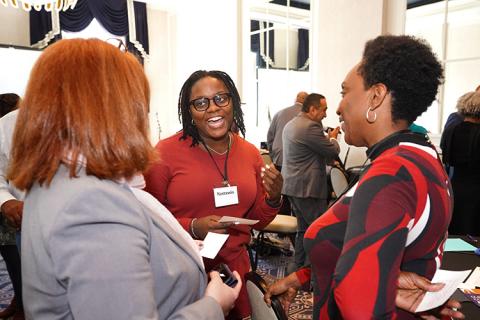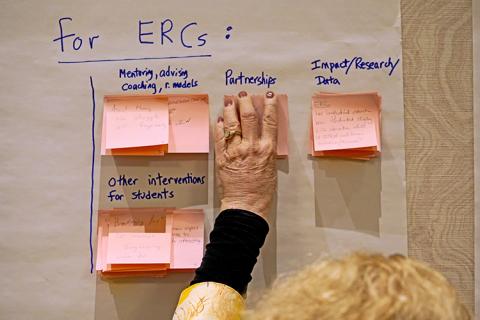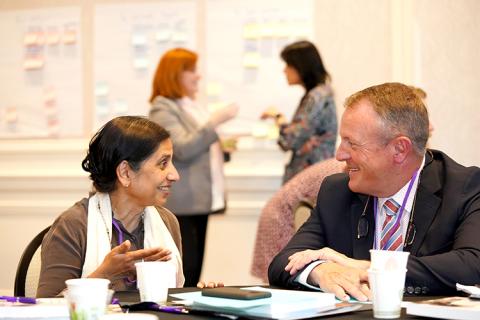The CNT and UW DO-IT co-hosted the ERC-INCLUDES Capacity Building Institute on April 4 and 5, 2019. This event enabled attendees from across the nation to share strategies to recruit, retain and engage underrepresented and underserved groups in science, technology, engineering and mathematics.
On April 4 and 5, the Center for Neurotechnology (CNT) and the Disabilities, Opportunities, Internetworking and Technology (DO-IT) Center hosted the ERC-INCLUDES Capacity Building Institute at the Graduate Hotel in Seattle. The goals of ERC-INCLUDES reflect those of the National Science Foundation’s (NSF) INCLUDES initiative, which focuses on broadening participation in research activities that are funded by the NSF.
Bringing attendees together to share their expertise is invaluable. The Institute offers real-time feedback about what is and isn’t working right now. It’s hard to get that kind of information from just reviewing the literature. During the Institute, we’re not looking for consensus. We want to capture a wide range of ideas for further reflection.
Scott Bellman, CNT associate director of diversity and DO-IT program manager
The Institute enabled attendees to share strategies to recruit, retain and engage underrepresented and underserved groups in science, technology, engineering and mathematics (STEM). The institute, along with other ERC-INCLUDES products, extends the work of an ongoing project called AccessERC, a CNT-funded initiative focused on sharing best practices that are informed by the needs of people with disabilities.
“ERCs can gain from the perspective of projects that have been funded under the INCLUDES program and vice versa,” said Sheryl Burgstahler, the founder and director of the DO-IT Center and the UW Access Technology Center, as well as the co-director of diversity for the CNT. “Attendees have the potential to communicate on an ongoing basis and provide resources for each other.”
Creating a community of practice across ERCs and NSF INCLUDES projects
Scott Bellman, a program manager at DO-IT and associate director of diversity for the CNT, said that the Institute created a space for conversation among people who work on NSF INCLUDES projects and in Engineering Research Centers (ERCs) like the CNT. The goal of collaboration and developing partnerships was echoed by attendees, who also expressed a specific interest in learning strategies to recruit and retain underrepresented and underserved individuals in STEM.
“Bringing attendees together to share their expertise is invaluable. The Institute offers real-time feedback about what is and isn’t working right now. It’s hard to get that kind of information from just reviewing the literature,” Bellman said. “During the Institute, we’re not looking for consensus. We want to capture a wide range of ideas for further reflection.”
The institute began with a brief introduction from Burgstahler. Afterward, Rajesh Rao, the co-director of the CNT, explained that one of the chief goals of the center is to use an interdisciplinary approach to develop neurotechnology for individuals affected by stroke and spinal cord injuries.
“We’ve been able to recruit and retain underrepresented minorities by demonstrating the impact of our science on people,” Rao said.
Most of the conference was devoted to sharing best practices for broadening participation in STEM, as explained by INCLUDES and ERC leaders. Throughout the conference, 12 attendees from across the country gave 20-minute presentations on best practices ranging from encouraging STEM engagement of minority males at a young age to broadening STEM participation in rural Georgia.
For example, the presentation by attendee Chien-fei Chen, the director of education and diversity at the Center for Ultra-Wide Area Resilient Electric Energy Transmission Networks, discussed the value of research at the intersection of social science and engineering to understand underlying social issues.
During presentations, attendees recorded promising practices or ideas that could be implemented in ERCs, INCLUDES projects, or universities. This information was then organized based on common themes like mentorship, partnerships, research designs and data collection.
Taking an intersectional and inclusive approach to broadening participation
On the second day of the Institute, Burgstahler shared a universal design framework, which is comprised of principles and practices to create inclusive and welcoming spaces. In this presentation, Burgstahler focused on how the framework could be applied to recognize and value the diversity of students with respect to race, disability, socioeconomic status, and learning style, and the intersections of these identities. She said that universal design provides students with multiple ways to obtain and demonstrate knowledge and to interact with fellow students, instructors, and course content.
“We look at intersectionality [and recognize that] the experiences of a student who is blind [and lives] in an urban community with a lot of resources may be very different than those of a person with the same disability [living in] in a rural area,” Burgstahler said. “The idea is to listen to people carefully. We can’t assume that one person, no matter how active they are in a field, can speak for an entire group.”
Burgstahler said the premise of universal design is to create environments, services and technology to be usable for all people. “In universal design, we minimize the need for accommodations, but we never eliminate them,” Burgstahler said. “Universal design has us look at the product and environment and say, ‘how can we make it more inclusive?’ Then, we provide accommodations if needed.”
Forming connections and sharing resources across institutions
Sylvia Mendez, an associate professor and chair of the Department of Leadership, Research, and Foundations from the University of Colorado, Colorado Springs, presented a theoretical framework of a mentorship model for underrepresented minority faculty members. Some of the tenets included using a hands-on approach when offering critiques on publications, and providing opportunities to share these faculty members’ work.
Mendez encouraged people to build on their own experience and that of others.
“The best way to find a good theoretical framework is being at [a conference] like this where you’re talking to people with shared interests and connecting on what frameworks drive their work,” Mendez said. “… It provides new ways of thinking about these phenomena, so I’m not only [grounded] in my own experience, but I’m also able to build on other people’s experiences as well.”
Liz Lehman, a conference attendee, shared her work on an INCLUDES Design and Development Launch Pilot to increase the STEM participation of black youth in Chicago. She shared how her project makes maps of critical stakeholders.
“Whose voices do we need to hear as we’re making this map to make sure it’s comprehensive and holistic? The map is only as good as the people at the table,” Lehman said. “If we leave someone out, we’re going to miss important pieces.”
After the institute, attendees will stay connected to further identify potential collaborations, create resources, and continue to share best practices. The conference proceedings will be published in a few weeks as a resource for attendees and other institutions.
For more information about this event and the CNT’s AccessERC initiative, contact Scott Bellman.






